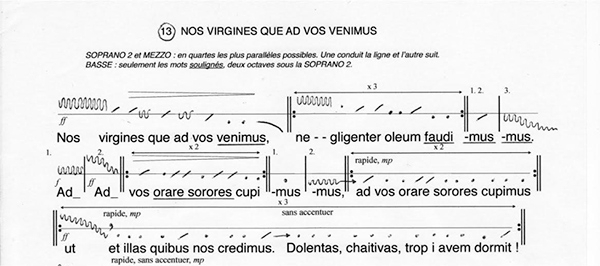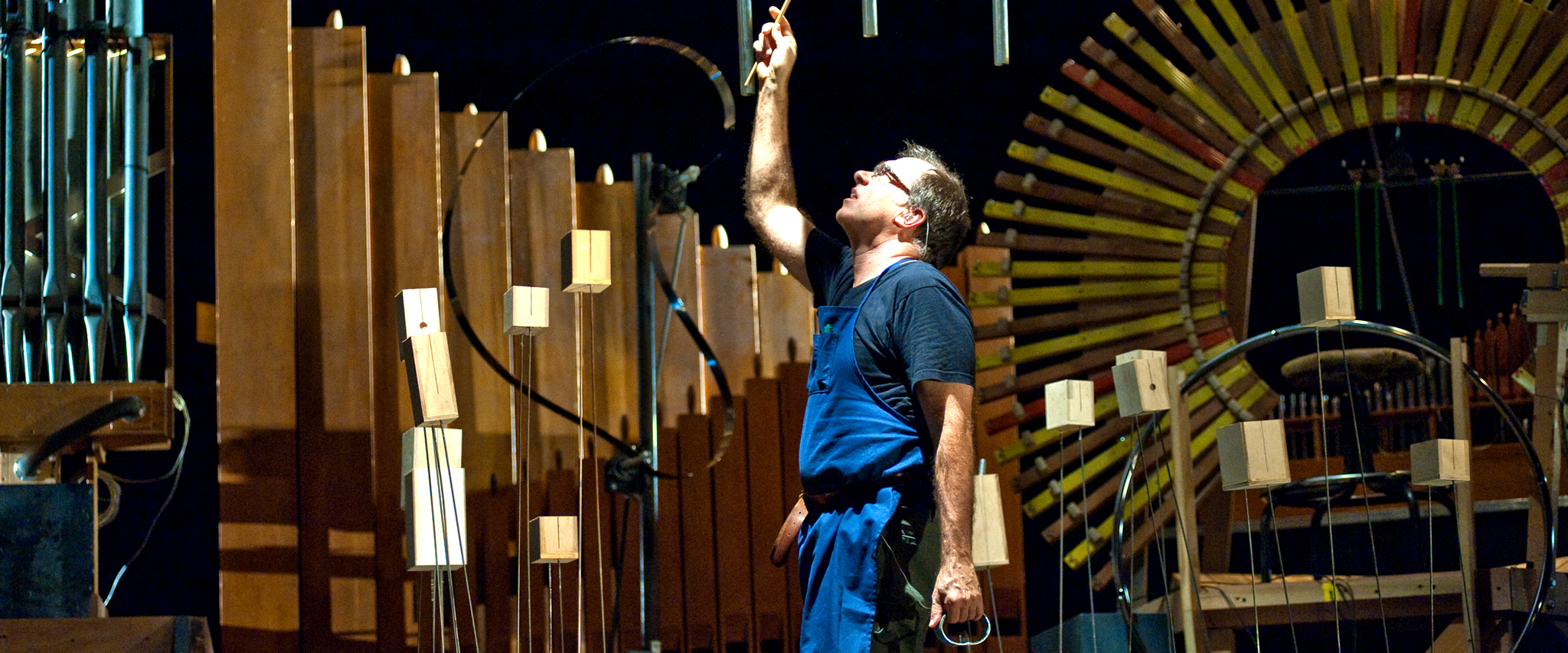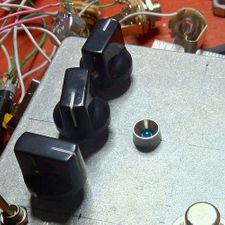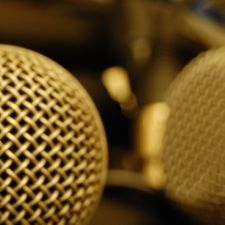By Michelangelo Merisi da Caravaggio, via Wikimedia Commons
The score has got you by the short hairs
When you think about it, the concept of music notation is pretty weird. Imagine if Andy Warhol had received commissions not for paintings, but rather for paint-by-number templates, to be realized by each art interpreter on their own canvases. Of course, we all know why music developed a notation system, but a recent email exchange with French composer Sasha Zamler-Carhart reminded me of the importance of not taking our practices for granted. Assumptions are baked into every aspect of music notation, often layered one on top of the other, and they color the kinds of music we can make.
Any notation system is about trade-offs: certain elements are emphasized over others for the sake of not overwhelming our human minds with their finite capacity for detail. After all, you could theoretically employ waveform print-outs as music notation, but that’s way too much detail to be useful in most performance contexts. By necessity then, the priorities of your practice inform its notation. But as soon as your notation exists, it throws its priorities right back in your face and informs your practice, more or less to the same extent.
Make too many wrong assumptions about a notation and you’ll quickly dig yourself into a hole. On the performing end of the equation, you’ll totally miss the point when it comes to wide swaths of repertoire, delivering lackluster interpretations that fail to reflect either the composer’s intent or your expressive talents. As a composer, you’ll limit your sound world to a small set of symbols—as the saying goes, when all you have is a hammer, everything starts to look like a nail—or conversely you’ll make it unnecessarily hard for performers to realize ideas that don’t fully fit the notation you’re using. So whether as performer or composer, you’ll have basically become the score’s whipping boy: conforming your music to the notation’s limitations instead of conforming the notation to your artistry.
New Music, Early Music

French composer Sasha Zamler-Carhart
In our exchange, Zamler-Carhart told me about his compositional practice, the frustrations he had as a student, and how he came to find his voice as an artist. For him, the problem lay in the seemingly uncontroversial advice his teachers offered on how new music works in the “real world”:
- You won’t get much rehearsal time
- Make your scores as clear as possible so ensembles can play your pieces after a few readings
- The best interpreters are technical virtuosi and perfect sight-readers
Yet Zamler-Carhart wasn’t satisfied with the results he was getting. Eclectic by temperament, he also studied early music, and in that genre he came across a set of practices that better resonated with his aesthetic:
- Music is rehearsed and reworked “endlessly until it sounds beautiful”
- If the music is worth performing, the time and effort required to realize the score are immaterial
- The best interpreters are those who bring “flawless elegance” to their playing
Zamler-Carhart has taken these principles to heart, and they have informed his practice ever since. Consequently, he prefers not to “work with musicians unless they can give me a lot of time (I mean weeks and months, not hours).” Once in rehearsal, he refines his interpretations orally, teasing out nuances via performance practice instead of ultra-precise notation, and this allows him to have meaningful exchanges with interpreters who are not new music specialists.
In Zamler-Carhart’s thinking, this works because performers who deal primarily with the music of the past expect a “triangular” relationship between notation, interpreter, and performance practice. There is the assumption that some of the information required will not be in the score—not that anything goes, mind you, but rather that sources outside of the printed page are necessary. Zamler-Carhart simply leverages this set of expectations. In his words:
Many early music performers are not used to seeing lots of dynamic and articulation markings in a score. They expect those elements to be part of performance practice and to be conveyed in rehearsal. An over-specific score can discourage them and give them the impression that the music is more difficult than it really is. Once in rehearsal, however, they will probably accept any change in dynamics, articulation, timbre and even tempo as part of normal rehearsal information, and they will incorporate that into their performance.
Naturally, Zamler-Carhart’s approach has certain implications: when he chooses to rely on oral performance practice, he also de facto excludes the resulting piece from much of the new music mainstream. The American Composers Orchestra is unlikely to spend “weeks and months” rehearsing a single piece with a single composer, so if you want to write orchestral music, the “early music” model is not for you. But that doesn’t mean it has no value. Too often we assume that the standard notational model and the performance practice it entails is the only path (or at least the unquestionably superior path). This isn’t true, and when you look closer, you’ll find that it comes with its own trade-offs and restrictions.
Realizing this, Zamler-Carhart has successfully used a range of notations (and non-notations) for his pieces, from a one-line vocal staff with neumes to modernist graphic scores, and from (selective) traditional notation to orally transmitted music to be learned solely by ear. He has even changed notational systems mid-piece when appropriate. However, what he does _not_do is turn the score into some kind of musical crossword puzzle: his choices are always based on the idea of making it as easy as possible to realize the musical vision at hand.

Excerpt from Zamler-Carhart’s oratorio Sponsus (2012), using a single line and neumes. He explains, “The piece is in fact polyphonic, but the polyphony can be realized from a single line so there’s no need to notate each voice.” Posted with permission.
The Right Tool for the Job

Percussionist Steven Schick in performance.
When it comes to building a career, the best musicians navigate the biases inherent in music notation in one of two ways: either (1) they restrict themselves to repertoire that works with their notational preferences, or (2) they switch notations based on the task at hand.
Percussionist Steven Schick provides a great example of the second approach. Earlier in his professional life, regular recital tours and prodigious quantities of new repertoire were central to his practice. On one end of the spectrum, he earned a reputation for his masterful interpretations of famously complex pieces such as Brian Ferneyhough’s Bone Alphabet (written for Schick in 1991) and Xenakis’s Psappha. On the other, he served as percussionist for Bang on a Can, performing works by David Lang, Steve Reich, Louis Andriessen, and other composers of the minimalist or post-minimalist vein.
These repertoires are not notated in the same way—indeed, there is significant variation even within each. The score to Reich’s Drumming is traditional yet sparse, and the phasing for which the piece is famous is simply described in text. Bone Alphabet, alternately, takes Cold War–era notational specificity to its extreme, with articulations and dynamics in virtually every bar, nonstop nested tuplets, and constant meter changes. Psappha, on the other hand, eschews traditional notation entirely in favor of a series of grids and tablatures.
Over the last decade, Schick’s musical priorities have evolved and so have the notational practices employed. He now focuses on collaborative, large-scale projects developed in tandem with composers, directors, instrument builders, writers, and other artists over an extended period of time. Take Schick Machine, his collaboration with Paul Dresher. A one-man, concert-length theater piece scored largely for invented percussion instruments, Schick Machine tells the fantastical story of a “mad scientist” percussionist who tinkers with instruments in his garage. Schick moves across a stage cluttered with dozens of custom-made instruments, narrating and performing as he goes, often to humorous effect. At certain moments the storytelling dominates, while at others the narrative gives way to purely instrumental “numbers” that feature specific groupings of percussion instruments. There are no breaks in the piece and the performance lasts over an hour.
Notating a piece like Schick Machine poses clear logistical challenges. Of course, you could detail every movement, gesture, speech, and musical figure with diagrams and staff notation. But would such a score convey the priorities of the piece? If the goal were to create a piece that gets played on every high school percussion recital the world over, perhaps. But that’s not the point—I mean, just look at the title. The piece is meant for Schick alone; the score only needs to be precise enough for him to remember how to realize a performance. Thus, they didn’t bother with a traditional score. Schick explains:
The piece was derived from improvisations and is still pretty largely improvised. There is a script and a sort of standard performance video that we made at the Mondavi Center…I use them together in lieu of a score.
At best, going through the motions of Cold War notational practice would have been a waste of time and a distraction. At worst, it would have “downsampled” the artistry of the piece, flattening the nuance of the Dresher/Schick vision into a long and complex series of approximations. Now, I am by no means arguing that Schick has rejected traditional notation entirely—he is still more than willing to read a score written in the new music fashion. But it is a testament to his creative talents that he can shift gears when the music demands it, as it does for this piece. A lot of musicians, even at the highest level, can’t do that.
Breaking the Unwritten Rules

JACK Quartet. Photo by Henrik Olund.
Of course, you can have a successful music career focusing entirely on a single notational practice, whether new music specificity, early music ambiguity, structured improv, standard orchestral practice, or whatever. But you still need to understand the priorities of your notation. There are always unwritten rules, and there are consequences to violating them.
A few months ago, I saw a Facebook exchange between a handful of composers who are in the same graduate composition program together. One of them had written a piece that is played at a single dynamic level throughout. As such, he had simply written f at the start of each part and left it at that; there were no further dynamics and no cautionary indications. Of course, the first thing the performers asked in rehearsal was, “Where are the dynamics?” His response was a snotty, “At the start of the piece.” Technically, the composer was using traditional notation correctly, but new music practice requires more specificity than he provided. The interpreters knew that most contemporary scores have a lot of dynamic detail, so without a cautionary indication, it is entirely reasonable for them to assume there had been a printing error.
Performers can, of course, get along fine without dynamics, but you can’t just assume they’ll figure out what you want—you need to point them in the right direction. Zamler-Carhart did just this with his St. Francis String Quartets, written for the New York-based JACK Quartet. The scores have virtually no dynamics, articulations, or tempo marks. Not unexpectedly, the quartet was a bit surprised at first, but they were willing “to engage with the piece and understand the logic of why, for example, a passage would be soft or loud even if it doesn’t say so… even with a concert looming.” For Zamler-Carhart, the experience was fulfilling and “the challenge improved the quality of performance.”
These exceptional cases aside, some skill in interpreting unwritten conventions is required even for the most banal of notational practices. Take the tenuto. Composer Sarah Kirkland Snider posted this question on Facebook awhile ago:
Poll of performers/conductors/composers: when you see a tenuto mark (horizontal dash over a note) without a slur, do you think of it as a request to alter the dynamic or the duration? (And if you’re a performer, tell me which instrument you play.)
Her query inspired 62 responses and a spirited debate that was never resolved. Answers ranged from “a color change” to “emotional pressing” to shorter duration, longer duration, a slight dynamic accent, “more weight,” and many other contradictory statements. The fact of the matter is that you can never get a single, objectively right answer to this question, because the tenuto has evolved as a sort of open-ended placeholder, begging to be repurposed. The only thing you can really say is that it means that something in the music should change.
Stuck Inside the Box
Taking notational practice for granted can hold you back in important ways. When I was a composition student at UC San Diego, we had a residency with the Arditti Quartet, perhaps the foremost interpreters of modernist string quartet repertoire and its diaspora. But their virtuosity in that genre doesn’t mean they excel at everything else quartet-related.
During the course of the residency, Irvine Arditti made it fairly clear that he has (or had) certain blind spots when it comes to notational practice. In particular, he seems to have bought into the Cold War ideal that the score is the music, objectively and completely. On several occasions he responded to requests for a change in interpretation with, “We’re just playing what’s in the music,” implying that the quartet’s interpretation was correct and that the composer had made a mistake in notation.
Yet my fellow composers and I, debriefing over beers, couldn’t help but feel that something was missing, that there was a degree of one-dimensionality to their playing. One of my colleagues later had his piece performed at June in Buffalo by another quartet of less lofty reputation, and he vastly preferred that interpretation to the Arditti’s. The other quartet was willing to take the time to learn how his notation worked and how to interpret the musical ideas that underlay it. Consequently, they realized it more faithfully.
Irvine Arditti might counter that we had all just written shit pieces. (You can decide for yourself, at least for my piece; their rendition is embedded below.) At numerous points throughout the residency, he complained that there were no young composers doing anything interesting anymore: the best of their works were bad copies of Lachenmann, and the worst were just plain bad.
I don’t think that’s the problem. Rather, the issue is that Irvine Arditti acts as if there were only a single, objective notational practice. Since he refuses to interpret notation in any way other than the Lachenmann/Stockhausen/Xenakis model, is it any surprise he can’t find nuance in other types of scores? The young composers he calls derivative probably are—I don’t doubt he knows Germanic post-serialism like nobody’s business. But move outside of that comfort zone, and he loses the ability to assess other styles on their own terms. Anything he is not willing to decipher becomes “not well written” and anything he can decipher is by necessity derivative. It’s a self-fulfilling prophecy.
Nor am I the only person to notice the effects of this blind spot on the Arditti Quartet’s interpretations. Their Beethoven renditions haven’t exactly met with critical acclaim, after all. Reviews like the following are typical:
…for most of the concert they seemed more concerned with just getting the notes together than with interpretation. This was especially, almost painfully, evident in the opening work, Beethoven’s Grosse Fuge in B-Flat Major, Op. 133. Beethoven, of course, is not exactly in the Arditti’s wheelhouse. But that’s still no excuse for iffy intonation, long stretches of uninflected dynamics, and questionable articulation.
If there were really only one objective way to use notation, this shouldn’t have been possible for a quartet of the technical caliber of the Arditti. Yet that’s what they served up. The Ardittis are perhaps the greatest string quartet interpreters of the Cold War modernist repertoire and its offshoots. Unfortunately, they are middling interpreters of everything else, because they assume all music works the same way.
Naturally, there are many successful paths between the Arditti Quartet and Zamler-Carhart’s ever-shifting notation. Nor am I advocating that everyone structure their careers like Steven Schick. But we as musicians in the classical tradition use notation pretty much all the time, and it’s worth reflecting on how that changes us. I don’t fault Irvine Arditti for liking the kind of music he likes, or for sticking to a single performance practice. But it is undeniable that his approach to notational practice has influenced his career.
Music notation is not the tabula rasa we pretend it to be. It is rather a tool for expressing specific kinds of sonic ideas, to specific kinds of people, for specific reasons. You don’t need a fancy graphic score or some kind of alternative tablature to completely transform the priorities of a notation, you just need a performance practice. If we ignore the unwritten aspects of notation, we’re likely to come away dissatisfied. If we keep them in mind, conversely, we’ll be more successful at creating music that speaks to us, whether as composers or performers.
This article originally appeared on NewMusicBox.




